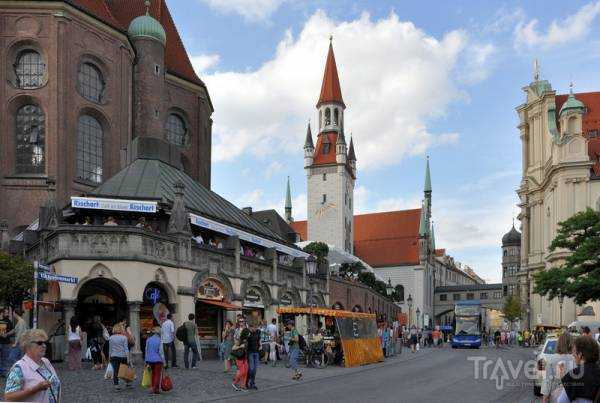I started this series with gingerbread towns in the Alpine foothills, and I want to finish it with sketches from the towns of lowland Bavaria.
Petersplatz, Munich

Augsburg
It is the oldest city in Bavaria and currently the third largest. It was founded by the Romans in 15 BC during the reign of Emperor Octavian Augustus, to whom the city owes its name. For the city's 1600th anniversary, which was celebrated in 1594, a fountain was built in the central square of Augsburg, which crowns statue of Augustus

The same square is home to the city hall, perhaps the most famous in the city. During the war it was completely destroyed, but was later restored. The city hall is known primarily for its magnificent Golden Hall, where Augsburg merchants, some of the richest in Europe, held their receptions.

Ceiling of the Golden Hall

Two views of Augsburg from the windows of the Town Hall
Elias Holl Square, one of the architects of Augsburg, the author of the Town Hall project

Church of St. Peter

Archbishop's Garden

The Augsburg Church of St. Anne is famous for the fact that Martin Luther stayed here in 1520, when he came to Augsburg for a theological discussion with the Catholic Cardinal Gaetan. The country was then divided into two camps - Catholics and Protestants, and religious wars began. Only 10 years later a law was adopted, called the "Augsburg Confession", according to which citizens had to profess the religion that their supreme ruler in the city or region professed.
Carved altar of the church of St. Anne

Interior view of the church - now it is decorated in the Baroque style

The most beautiful cathedral in Augsburg is probably Basilica of Saints Ulrich and Afra. It is approached by the wide Maximilianstrasse, at the end of which one can see churches adjacent to each other: a large Catholic basilica and a small Protestant church of St. Ulrich.

Main nave basilicas

Carved wooden altars early 17th century

Openwork latticework framing the entrance to the basilica

Munich
Munich is different for everyone – like any big city, I suppose. Personally, I like two places here: Viktualienmarkt – a huge food market in the city centre and the Old Pinakothek with its magnificent collection of paintings.
On Viktualienmarkt you immediately understand how Bavarians love to drink beer. Like this, in neat and tight rows

Or like this - with an accordion and violin

Gifts of the forest and folk crafts


"Maypole" on Viktualienmarkt is probably the highest in Bavaria. Putting up such "trees" at early summer festivities is an ancient tradition dating back to pagan times

Famous Hofbräuhaus - an incredibly large beer hall for 4000 people, which was visited by Mozart, and the Bavarian kings, and our Ilyich, and Nazi leaders. In the morning it is still practically empty. Only a few regulars fill up here early in the morning.


The heart of Munich is Marienplatz square in front of the city hall


Town Hall CourtyardOf course, there is a beer hall here too.

Isar Gate (14th century) – one of the three surviving gates of the city. They were once part of the fortress wall surrounding Munich.

A corner of the old town

…and the border of the new at Charles Gate. Karlsplatz

Munich has a large number of churches with majestic interiors.
St. Michael's Cathedral

IN Church of the Holy Spirit We saw a whole forest of columns, artificial trees and an unusual flock of flying paper cranes.


Monument to Little Red Riding Hood

Gazebo in the Hofgarten park

English park

Staircase in Alte Pinakothek reminiscent of the imperial architecture of the Third Reich, although it was built in the 19th century

But the gaze and soul rest here on the masterpieces of Renaissance painting.

Master of the Life of Joseph. Joseph and Potiphar's Wife, c. 1500

Master of the St. Bartholomew Altar. St. Bartholomew, detail. Circa 1500

Derek Bouts. The Judas Kiss, 1465

Albrecht Durer. Self-portrait, 1500

Filippo Lippi. Madonna and Child, detail. 1460s

Parmigianino. Mary with Child. 1533-1535
Source: travel.ru
